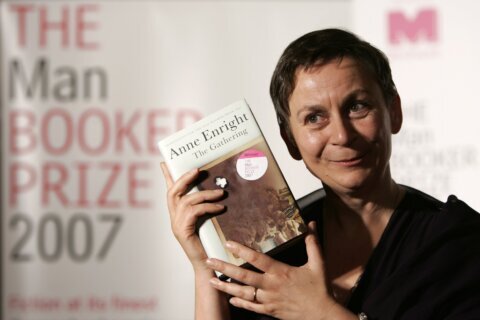Listen to our full conversation on my podcast “Beyond the Fame.”
Movie stars get all of the attention, but movie magic is often created behind the scenes.
Phil Tippett has crafted the Oscar-winning special effects in classics from “Star Wars” (1977) to “Jurassic Park” (1993) and is heading a new animated feature “Mad God.”
“I started after ‘RoboCop 2’ [1990] and shot about three minutes of material, but realized the scope and scale of the thing was too big,” Tippett told WTOP.
He returned to it starting in 2010, financing his “Mad God” series via Kickstarter until there was enough material to create a feature film. He says the plot is “impossible” to describe.
“There’s no story,” Tippett said. “There is a narrative and a logic to it, but it really flies in the face of conventions about narrative filmmaking. It’s like a collage, it’s a bunch of different techniques from stop-motion animation to computer graphics to high-speed miniatures and a high-speed character that we call The Alchemist that was shot 120 frames per second and composited into live action.”
The result is an experimental film with a surrealist approach.
“I was very influenced by the surrealist artist Joseph Cornell, who made these wonderful boxes and collages of materials that he would find over the years,” Tippett said. “He would go to junk shops and antique shops and just find stuff. A lot of his stuff is very well organized, unlike me. … My process is very similar. I collect tons of junk. A lot of it made it into ‘Mad God’ as a prop.”
He says the film pushed him to the limits of his own mental state.
“I’m bipolar,” Tippett said. “My manic side is my secret power. I can just work and work and work until I drop dead. In fact, toward the end of the [film] … I began to disintegrate and I hated working on ‘Mad God.’ … I had a mental breakdown and had to go to the psyche ward. It took me about two months to recover. I went down this really dark path and became a victim of my own movie.”
It paid off when the film made its world premiere at the Locarno Film Festival in Switzerland, where Tippett received the Vision Award Ticinomoda for his legendary career of visual effects.
“It was a bigger deal than I had anticipated,” Tippett said. “I knew it was going to be in the grand piazza, but there were 6,000 people there, so that was daunting. I had to think quick about how to be humorous and entertaining to 6,000 people.”
How did this lifetime achievement award come to be? Born in California in 1951, Tippett grew up watching stop-motion gurus Willis O’Brien and Ray Harryhausen.
“When I was 5 years old, I saw ‘King Kong’ on television, then in 1958, ‘The 7th Voyage of Sinbad,'” Tippett said. “Those really galvanized my path, but I had no idea what the technique was. When you saw a movie [back then], you probably wouldn’t be able to see it again for another 10 years or so on television. … This was really helpful as opposed to information overload.”
By the late 1970s, writer/director George Lucas hired him to work for his visual effects company Industrial Light & Magic (ILM) on “Star Wars” (1977), including the chess board sequence.
“George wasn’t happy with the cantina scene,” Tippett said. “He thought all the creatures looked like ‘Beatrix Potter’ creatures. So he was able to talk Fox out of some money to have a bunch of costumes made. He hired Rick Baker, and Rick hired four out-of-work stop-motion animators and over about six weeks the direction from George was to make as many space aliens as you can.”
He won a special Oscar for “Return of the Jedi” (1983) before working on Steven Spielberg’s “Indiana Jones and the Temple of Doom” (1984) and Paul Verhoeven’s “RoboCop” (1987). Along the way, he stayed in touch with Hollywood computer graphics pioneer Dennis Muren.
“Dennis would call me over to ILM to look at some of the first computer graphics stuff he was doing like the stained glass man in ‘Young Sherlock’ and the water-snakey thing in ‘The Abyss,'” Tippett said. “So, I was aware of the progress and thought computer graphics were only going to be used for loose effects that you couldn’t get with stop-motion, but one thing led to a next.”
The turning point came in Spielberg’s “Jurassic Park” (1993), a landmark moment when visual effects shifted from Tippett’s stop-motion miniatures to Muren’s computer graphics. Tippett turned to Spielberg and said, “I think I’m extinct,” a line that made it into the movie for Jeff Goldblum.
“‘Jurassic Park’ changed everything,” Tippett said.” The guys at ILM proved that they could make a dinosaur that looked real and Steven just decided to go that way. I reacted overly emotional. I got really sick with pneumonia and really depressed and had to stay in bed for about two weeks.”
Ultimately, they compromised by mixing CGI dinosaurs and stop-motion animatronics.
“We designed the movie with Stan Winston and his team,” Tippett said. “My crew did the tyrannosaurus paddock and the raptor kitchen with these input devices that were essentially stop-motion animation armatures with encoders on them, so the traditional stop-motion guys who knew about weight, mass and performance could get it through stop-motion. … It was very elaborate.”
His T-rex paddock and raptor kitchen scenes became two of the scariest movie moments of all time, while the James Earl Jones narrated “The Making of Jurassic Park” (1995) remains one of the most fascinating behind-the-scenes filmmaking documentaries ever produced.
Today, if you see special effects, from movies like “Starship Troopers” (1997) to TV series like “The Mandalorian” (2020), there’s a good chance that you’ll see Tippett’s name in the credits.
Listen to our full conversation on my podcast “Beyond the Fame.”








